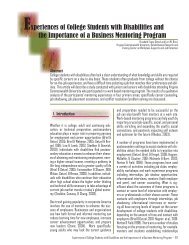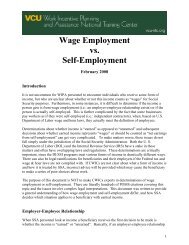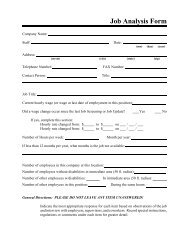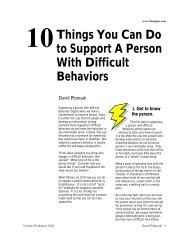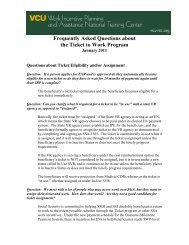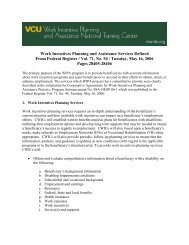INSIDE - Worksupport.com
INSIDE - Worksupport.com
INSIDE - Worksupport.com
- No tags were found...
Create successful ePaper yourself
Turn your PDF publications into a flip-book with our unique Google optimized e-Paper software.
Tapping New Talentfor Business SuccessHighlightsfrom theVCU-RRTC’s CharterBusiness Roundtable’sNational Study ofEmployers’ Experienceswith Workers with Disabilitiesreveal: Overall, employersview employees withdisabilities as capableand productive. Human Resourceprofessionals don’tview the cost of ac<strong>com</strong>modations,training, oradditional supervisionfor employees withdisabilities as a barrierto employment.January, 2002 Vol. 1, No. 3Employing People with DisabilitiesWorkplaceAc<strong>com</strong>modations:Inexpensive & EffectiveDespite the misconception that the cost of job ac<strong>com</strong>modation is high, thefacts indicate the opposite: The Job Ac<strong>com</strong>modation Network (JAN), an informationalservice sponsored by the Office of Disability Employment Policy, reported that the cost ofac<strong>com</strong>modations is typically very low, approximately $200.00 per employee with a disability.A recent Annenburg study of job ac<strong>com</strong>modations made national by Sears, Roebuck andCompany found an even lower typical cost of less than $50.00.IBM CONTINUES ITS LONG-STANDING COMMITMENTTO PEOPLE WITH DISABILITIESAt IBM, people are hired based on their abilities. IBM employeesrepresent a talented and diverse workforce, and achievingthe full potential of this diverse workforce is a fundamentalcorporate priority. Millie DesBiens, IBM Program Manager forWorkforce Diversity Initiatives, explains that in 1985, IBMinitiated a strategic objective to be<strong>com</strong>e the high-tech <strong>com</strong>panyrecognized for its leadership in developing products forpeople with disabilities. “We made significant progress sincethen in hiring people with disabilities and putting into placeac<strong>com</strong>modations to support them.”This article provides examples of the proactive approachdeveloped by IBM to workplace ac<strong>com</strong>modations forpeople with disabilities in areas such as:Work Experience andLeadership Programs forYouth with Disabilities;Active Recruitment;Creating a Barrier FreeWork Environment;A Corporate Focal Pointfor Disability RelatedIssues; andAc<strong>com</strong>modations forIndividual Workers.(Continued on Page 2) Employers believe theyare most effective inretaining existingworkers who acquiredisabilities and arrangingac<strong>com</strong>modations asopposed to hiring newworkers with disabilities. Employers rely oninternal organizationalresources that areavailable to assist inac<strong>com</strong>modating workerswith disabilities. Supervisors expressconfidence in theirability to identify anddevelop ac<strong>com</strong>modations.This newsletter is a jointpublication of VirginiaCommonwealth University’sSchool of Education, Dept. ofPhysical Medicine, RehabilitationResearch & TrainingCenter on Workplace SupportsIBM 7<strong>INSIDE</strong>THIS ISSUEBANK OF AMERICA AND THE AMERICANS WITHDISABILITIES ACTBank of America is a <strong>com</strong>panydedicated and <strong>com</strong>mitedto hiring, valuing, andpromoting individuals fromall walks of life. A key partof the <strong>com</strong>mitment is supportingthe principles of theAmericans with DisabilitiesAct (ADA) and honoring it’sgoals and objectives. Sincethe ADA’s inception, Bankof America has been recog-nized as a leader in providingequal opportunity to allindividuals, regardless oftheir disability status. “Weare proud of this legacy andwill continue our practices ofpromoting and advocatingequal access and opportunityfor everyone including peoplewith disabilities” says KateMoore, Coordinator of theAc<strong>com</strong>modations Unit.(Continued on Page 4)Workplace Ac<strong>com</strong>modations:Inexpensive & Effective ............................ 1IBM ....................................................... 1-3Bank of America ............................... 1, 4-6Manager’s Corner ................................ 6-8©2002, VCU-RRTC on Workplace Supports -- Permission to Reproduce -- Additional Copies: 25/$9.95 1
IBMIBM’s ac<strong>com</strong>plishments in ac<strong>com</strong>modating workers with a disability have been recognized by We Magazine and theOffice of Disability Employment Policy at the U.S. Department of Labor.In 1999, IBM took an important step towards fully integrating people with disabilities into its workforce by expandingits policy of reasonable ac<strong>com</strong>modations worldwide. All buildings leased or owned by IBM must be accessible topeople with disabilities. By making this policy global, IBM literally opened the door to the integration of people withdisabilities in its workforce.In its corporate program, Ms. DesBiens serves as the contact person for all issues related to people with disabilities.The corporate program includes an information-rich intranet site that contains data on IBM’s disability relatedprograms, ac<strong>com</strong>modations and resources, as well as an extensive listing of external resources. Ms. DesBiens alsomanages a corporate account used to fund ac<strong>com</strong>modations“We want to make sure that budget concernsdon’t get in the way of hiring and supportingthe need of our employees with disabilities.”for workers with disabilities throughout the <strong>com</strong>pany. Sheexplains. “We want to make sure that budget concerns do notget in the way of hiring and supporting the needs of our employeeswith disabilities.”Youth Programs and RecruitmentTo attract people with disabilities to the corporation, IBM runs a number of programs. A sample look at two suchprograms is presented below.ENTRYPOINTEntry Point was developed by the American Association for the Advancement of Science,IBM, and NASA. The program’s mission is to place youth with disabilities in business andindustry and prepare them for corporate and <strong>com</strong>munity leadership.Entry Point college and summer interns <strong>com</strong>bine two to five years of work experience at aclient organization like IBM with year-round academic instruction and training. Studentsmust have technical majors and maintain a grade point average of 3.0.Ms. DesBiens states, “We provide a meaningful summer or up to six-month assignment,ensure skill building in the technical field, provide necessary job-related reasonableac<strong>com</strong>modations, and assign a mentor to work with the student. The program isdesigned as a pipeline to part-time or full-time employment and we’ve found it a veryeffective way to recruit talented, technical college graduates.”See the story on the following page on Tim Scamporinno, an Entry Point graduate.PROJECTABLEProject Able was developed by IBM’s staffing and global workforce diversity organizationwith the aim of increasing the number of employees with disabilities at IBM. Theprogram’s goals include increased hiring, establishing a network to identify top qualitypersons with disabilities, and the establishment of a network of line championsthroughout the organization.DesBiens explains, “Our mangers are very receptive to the idea of hiring people withdisabilities. Most of them, however have no direct experience. So we use this program asa way to educate them and assist them every step of the way. She also states, “We haveexperienced managers in every organization that can answer any question and providesupport. Project Able has been an effective program for us and has done much toeducate our workforce.”2
Tapping New Talent for Business Success -- January, 2002TIM SCAMPORINNOENTRY POINT PROGRAMTim Scamporinno has excelled at IBM in his brief 18 month tenure with the<strong>com</strong>pany. Scamporinno, despite impressive academic credentials, was frustrated with hissearch for meaningful summer employment. Scamporinno’s faculty advisor at SonomaState was constantly fielding requests from area businesses for a chance to interview top<strong>com</strong>puter science majors. “I went on a number of interviews, but once they saw me andmy disability, that was it.” An accident 15 years ago left Tim a quadriplegic in awheelchair with limited use of his hands. The Entry Point Program at IBM proved to bejust the opportunity for him. After interviewing at the <strong>com</strong>pany, he was offered a numberof positions. He began as a summer intern in May, 1998, and three months into hisassignment was offered a full-time job. Being a new employee at IBM Tim wasassigned a mentor in his department who coached him on job skills, answered questions,and introduced him to various teams.As far as his disability, Tim says the attitude at IBM from day one was awillingness to do whatever needed to ensure that he could do the job. “It hasn’t been anissue because many of the things that can be obstacles were already taken care of,” saysTim. As far as work-related aids, he uses a hand tool to help him type. With a recentpromotion and the additional demands of 20 or so folks reporting to him he is lookinginto dictating software to help him to be more productive.JAMES FARRUGGELLACHAMPIONS PERSONS WITH DISABILITIES AT IBMJamie Farruggella, Professional Development Manager, IBM Global Services,feels his role is to support his people and help them succeed. When he accepted amanagement position in 1997 his first question to his staff was “how can I help you bemore productive?” For Dave Schoentag and Tim Mackey, that question had specialmeaning, both employees are disabled.“I had no direct experience working with people with disabilities,” saysFarruggella. “I felt strongly, though, that IBM had a genuine <strong>com</strong>mitment to its peopleand that meant full support of its workers.” As far as Dave and Tim went, Farruggellasays he didn’t think of supporting their productivity any differently.Most of the ac<strong>com</strong>modations for Tim and Dave were already in place. ForDave, who is blind, screen readers and a Braille display device helped him to do his joband for Tim, who is deaf, an interpreter was needed in certain situations. Farruggellastates that, “for both Tim and Dave, the ac<strong>com</strong>modations weren’t difficult. IBM is<strong>com</strong>mitted to making ac<strong>com</strong>modations to ensure employees with disabilities are able todo their jobs and fully participate in work life. This is underscored by the fact thatac<strong>com</strong>modations are funded through a corporate account.”Beyond ac<strong>com</strong>modations, Farruggella felt his team needed to be informedabout how best to work with Tim and Dave, so both employees gave presentations to thegroup to clear up any issues they may have. With his interest aroused, Farruggellabegan a personal journey on the issue of disability. “I wanted to stay up to date on whatwas available, I researched a number of resources that helped me learn more and, Ithink, helped me be <strong>com</strong>e a better manager.”As a line champion, Jamie Farruggella continues to put forward the issues ofpeople with disabilities, “we have to increase awareness, sensitivity, and do more to tapthis resource of talented individuals.”Thanks to his efforts, IBM continues to make progress in making sure its disabledemployees reach their full potential, as well as attracting people with disabilities to thecorporation.3
Bank of AmericaBank of America understands that creating meaningful employment opportunities for people with disabilities ismore than a value, it means more than just bringing people to the door. The <strong>com</strong>pany’s success in providingemployment opportunities for people with disabilities is derived from a long-standing pledge to provide <strong>com</strong>prehensiveprograms that anticipate and respond to the needs of future and current associates with disabilities. Toensure an integrated approach to meeting the employment needs of people with disabilities, Bank of America hasestablished several programs over the years. A sample of these resources and programs are presented below.PROGRAMS ANDRESOURCESOutreach and Recruitment Activities: The bank’s staffing departmentworks closely with both national agencies and local <strong>com</strong>munity basedorganizations to provide people with disabilities equal access to the<strong>com</strong>pany’s many employment opportunities.Disability Resources Intranet Site: This web-based service is designed toserve as a corporate resource and clearinghouse for associates and/ormangers with disabilities with a web site that is designed to connect associateswith tools, resources, and programs that support employees throughouttheir career at the bank.Abilities Scholarship Program: The bank promotes greater educationalaccess for people with disabilities through this scholarship program by earmarkingup to $200,000 to provide students with disabilities educationalopportunities that will prepare them to be<strong>com</strong>e a successful part of theworkforce.Alternative Formats Program: Once a need for an alternative format isidentified, applicants and associates automatically receive <strong>com</strong>munications intheir preferred format to include: braille, large print, or electronic media.Most documents are stored in alternative formates to ensure immediateaccess to information.Disability Ac<strong>com</strong>modation Fund: Despite the fact that many ac<strong>com</strong>modationscost little or nothing this program was designed to ensure that hiringdecisions are solely focused on the <strong>com</strong>petencies of the applicant with allreasonable ac<strong>com</strong>modations provided through the fund.The following section provides detailed information on how Bank of Americautilizes an ac<strong>com</strong>modation case manager to ensure equal access to employmentand career advancement for their associates and managers.REASONABLEACCOMMODATIONSBank of America is more interested in what people can do than what they can’tdo. That’s why they base all of their employment decisions on capabilities ratherthan disabilities. The Bank recognizes that people with disabilities may requirereasonable ac<strong>com</strong>modations to have access to employment opportunities, to besuccessful in performing their jobs, and to be able to fully participate in bankactivities and programs.To assist recruiters and managers to stay focused on the capabilities of individualsand to ensure those who need ac<strong>com</strong>modations receive them, they have establisheda first-class ac<strong>com</strong>modations program. By calling a single telephonenumber an individual can request <strong>com</strong>prehensive disability case management,including ac<strong>com</strong>modations consultation, identification, and implementation, froman ac<strong>com</strong>modations specialist.4 ©2002, VCU-RRTC on Workplace Supports -- Permission to Reproduce -- Additional Copies: 25/$9.95
Tapping New Talent for Business Success -- January, 2002THE BASICSReasonable ac<strong>com</strong>modations are modifications to the work environment thatremove job-related barriers, create a level playing field, and foster equal accessand opportunity for people with disabilities. The need for a reasonable ac<strong>com</strong>modationcan occur in any stage of employment; from an ac<strong>com</strong>modation for anapplicant in the hiring process, to an ac<strong>com</strong>modation for an existing associatewho be<strong>com</strong>es disabled. The ADA requires reasonable ac<strong>com</strong>modations in orderto:1. ensure equal access in the application/selection process;2. enable a qualified individual with a disability to perform the essential jobfunctions; and3. enable a person with a disability to enjoy the same benefits and privileges ofemployment as others enjoy (training, social events, benefits, etc.)TYPES OFACCOMMODATIONSAn appropriate ac<strong>com</strong>modation will depend on the situation and will need to belooked at on a case-by-case basis. Not all ac<strong>com</strong>modations will be appropriateor effective for all types of jobs within the bank. An Ac<strong>com</strong>modation Case Managerwill help identify an effective solution that does not put undue hardship onthe <strong>com</strong>pany. The ADA does not require employers to lower quality or quantitystandards as an ac<strong>com</strong>modation. The basic ac<strong>com</strong>modation categories are: Restructuring Jobs Acquiring Assistive Equipment or Devices Removing Barriers Providing Alternative Formats ofCommunications Modifying Work Schedules Reassignment to a Vacant PositionREQUESTING ANACCOMMODATIONIt is up to the applicant or the associate with the disability to request an ac<strong>com</strong>modationif needed. There is no obligation of the employer to provide an ac<strong>com</strong>modationif the person chooses to conceal their disability. Managers should notspeculate whether or not an individual has a disability or requires an ac<strong>com</strong>modation.They should create an atmosphere where associates are <strong>com</strong>fortablemaking such requests if the ac<strong>com</strong>modation would assist them in performing theessential job functions.Ac<strong>com</strong>modation Case Managers, on staff at the bank, are available to work withthe individual from the beginning of the reasonable ac<strong>com</strong>modation process tothe end. They also ensure that the <strong>com</strong>pany meets its obligations under the ADAand other state disability laws. Ac<strong>com</strong>modation Case Managers will work withthe individual to:1. determine if a physical or mental impairment is covered under the ADA orstate disability law;2. facilitate the interactive process;3. attempt to identify a cost effective reasonable ac<strong>com</strong>modation for theindividual with the disability;4. procure the necessary equipment or services;5. provide the necessary funding for the ac<strong>com</strong>modation; and6. implement the identified ac<strong>com</strong>modation.5
Linda Schaedle, an employee ofBank of America, has Guillain-Barre Syndrome. Guillain-Barre issimilar to Multiple Sclerosis inthat the conductive portion(myelin) of the peripheral nervesis attacked by the body’s ownimmune function. While a studentat UCLA, Linda had her firstattack which resulted in <strong>com</strong>pleteparalysis. This happened many years ago when there was no therapy available. Curbcuts, automatic doors, ADA, or reasonable ac<strong>com</strong>modations were also not available.Currently, Linda uses a power wheel chair and specialized tools for functioning due tomuscle weakness and endurance issues.A recent exacerbation of Linda’s Guillain-Barre Syndrome left her with<strong>com</strong>pounded nerve damage. When she was ready to return to work, a consultantperformed an ergonomic evaluation and the ac<strong>com</strong>modation process began. Throughthe efforts of her case manager, supervisor, and therapists, she was able to return towork at Bank of America. Some of the ac<strong>com</strong>modations that were made to assistLinda in her return to work included: voice activated software, an ergonomic chair,keyboard, trackball mouse, and a front door entry with an extended security windowfor badge entrance, allowing wheel chair passage, before locking again.While ac<strong>com</strong>modations were being made for Linda to return to her formerwriting position, her department was eliminated through restructuring. Bank ofAmerica’s management offered her the opportunity to move into a Case Managementposition. Linda says she is “thrilled to be here and to work with such a remarkableteam where possibilities be<strong>com</strong>e realities. You just never know when you could end upon the other end of the telephone, as I did. If that happened, what would you do?”PROFILE: LINDA SCHAEDLE’S RETURN TO WORK ATBANK OF AMERICA“Bank of America is remarkable, and I’m honored to bepart of the team. It is a place where we are valued forour talents and abilities and the unique qualities that weall bring to the team.”Manager’s Corner.....Ask the ExpertIf a manager has never hired or worked with a person with a disability, questions may <strong>com</strong>e to mind. Theseunanswered questions can create hesitation in hiring applicants with disabilities. This column is a regular featurein this newsletter and is intended to answer questions, present facts, and share strategies for recruiting andretaining employees with disabilities. Frequently asked questions about people with disabilities and reasonableac<strong>com</strong>modations are presented below.Question & AnswersQQUESTION #1Are ac<strong>com</strong>modationsexpensive?AFor most situations job ac<strong>com</strong>modations are notexpensive. However, there may be situations in which thetype of job ac<strong>com</strong>modation may require high technologyand can be costly. According to the Job Ac<strong>com</strong>modationNetwork (JAN) based out of West Virginia University, theac<strong>com</strong>modation cost reported by businesses show 20% ofac<strong>com</strong>modations cost nothing at all. JAN also reports that50% of the ac<strong>com</strong>modations cost less than $500 and morethan 80% cost less than $1,000. Ac<strong>com</strong>modations arespecific to the needs of each individual and the job requirement,but JAN reported that only 9% of the ac<strong>com</strong>modationcost between $2,000 and $5,000 with only 3% costingmore than $5,000.6 ©2002, VCU-RRTC on Workplace Supports -- Permission to Reproduce -- Additional Copies: 25/$9.95
Tapping New Talent for Business Success -- January, 2002QWhat should an employer dofollowing a request for anac<strong>com</strong>modation?QQUESTION #3As an employer do I have tomake an ac<strong>com</strong>modation if it isrequested?QQUESTION #2QUESTION #4What are some examples oftypical job ac<strong>com</strong>modations forsomeone with a psychiatric disability?AThe first step is to identify the specific disability. Itwill be important to conduct a needs assessment to identifyac<strong>com</strong>modations appropriate for the each individual request.Once you have determined there is a disability thenyou should review the job description to identify the essentialfunctions of the job and which functions require ac<strong>com</strong>modations.Once you have an understanding of the ac<strong>com</strong>modationsneeded, you can begin to explore a variety ofac<strong>com</strong>modations that reduce or remove the barriers andassist the individual to meet the requirements of the job.After the specific ac<strong>com</strong>modation(s) has been identified, thenext step is too determine cost effectiveness of each ac<strong>com</strong>modationrequired by the employee. Lastly, you will need toimplement the most appropriate ac<strong>com</strong>modation with theleast economic hardship for the business.AYes, unless an employer can prove undue hardshipusually the ac<strong>com</strong>modation will have to be made if theperson has a disability. An ac<strong>com</strong>modation may be consideredan undue hardship if it exceeds the bounds of practicality.That is, an employer would not be required to provide anac<strong>com</strong>modation if it cost more than alternatives that areequally effective, requires extensive and disruptive renovations,or negatively affects other employees or customers.Undue hardships are determined on a case-by-case basisusing the following criteria: the cost and nature of the ac<strong>com</strong>modation; the overall financial resources of the organization; the overall financial resources of the employer; and the type of business of the covered employer.AEvery situation is different and must be consideredon an individual basis to determine the best ac<strong>com</strong>modationthat will not pose an undue hardship and allow the worker tobe productive at the workplace. However, if a person hasproblems maintaining stamina during the workday, thepossible ac<strong>com</strong>modation might be : provide flexible scheduling or allow job sharing or redistribution of work.If the person has difficulty concentrating you may consider: reducing distractions in the work area, dividing large assignments into smaller tasks, or providing space enclosures.There are other simple ac<strong>com</strong>modations that can be used,such as making “to do” lists, giving written job instructions,writing clear expectations or responsibilities and consequencesfor not meeting the expectations, providing directions in aconsistent manner, and using one-to-one supervision.7
QQQUESTION #5Is employing someone with adisability who needs an ac<strong>com</strong>modationa “big deal”?QUESTION #6Can job ac<strong>com</strong>modations helpme increase my pool of qualifiedapplicants?AManagers and supervisors fear that providingac<strong>com</strong>modations to workers with disabilities may break thebudget and this fear has kept a lot of employers from hiringpeople with disabilities. However, employers who haveexperience in hiring and ac<strong>com</strong>modating individuals withdisabilities have reported that it is not a “big deal”. Most ofthe time employers report that hiring and making ac<strong>com</strong>modationshas been easy and very simple. The more informationand resources an employer can provide to it’s managersand hiring supervisors, the greater the opportunity to reducethe fear and uncertainty they may have about providingac<strong>com</strong>modations.AWith labor shortages and fierce <strong>com</strong>petition forattracting and retaining qualified workers, a knowledge ofjob ac<strong>com</strong>modations can be key to tapping into the pool ofqualified employees with disabilities. Businesses who seethrough disabilities and perceived obstacles will understandthat people with disabilities bring skills and abilities to theworkplace and will move ahead of their <strong>com</strong>petitors inrecruiting efforts.AVAILABLE RESOURCESJob Ac<strong>com</strong>modation Network (JAN) providesanswers to questions such as:What does an employer need to know in order torecruit, retain, and advance employees with disabilities?How can the valuable expertise of an existing employeebe retained when an employee develops a disability?JAN consultants will provide focused, concise answers tothese and other questions that confront management. This isa no cost service for employers which gives practical toolsfor applying ac<strong>com</strong>modation information and help to clarify<strong>com</strong>plex ADA questions like “reasonable ac<strong>com</strong>modation.”Contact: 1-800 526-7234http://www.jan.wvu.eduThis newsletter, “Tapping New Talent forBusiness Success” has been bundled ingroups of 25 and can be purchased for$9.95. If you are interested in receivingadditional newsletters please send yourrequest to the editor:VALERIE BROOKEVCU/RRTCP.O. BOX 842011, 1314 W. MAIN ST.RICHMOND, VA 23284-2011(804) 828-1851 VOICE(804) 828-2494 TTY(804) 828-2193 FAXor e-mailvbrooke@saturn.vcu.eduEDITORS: Valerie Brooke & Paul Wehman -- CONTRIBUTORS: J. Howard Green and Jennifer ToddMcDonough, VCU-RRTC, Kate Moore, Coordinator of Ac<strong>com</strong>modations Unit, Bank of America, Joan A.Stapleton, & Millie DesBiens, Program Managers of Workforce Diversity Initiatives, IBMLAYOUT & DESIGN: Jeanne Roberts8VCU School of Education and Department of Physical Medicine and Rehabilitation is an equal opportunity/affirmative actioninstitution and does not discriminate on the basis of race, gender, age, religion, ethnic origin, or disability. If specialac<strong>com</strong>modations are needed, please contact Valerie Brooke at VOICE (804) 828-1851 or TTY (804) 828-2494. Funding for thisproduct is provided by grants (#H133B980036 and #H133N950015) from the National Institute on Disability and RehabilitationResearch (NIDRR) with the U.S. Department of Education.



